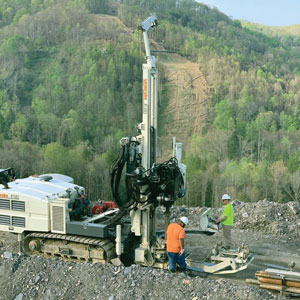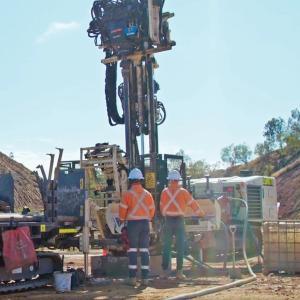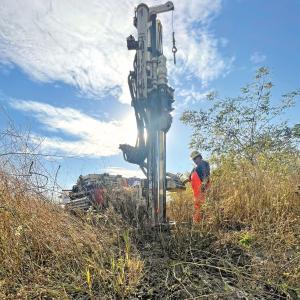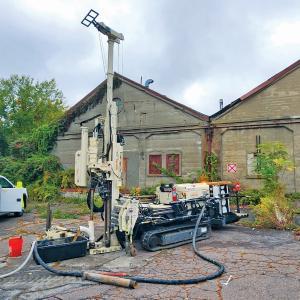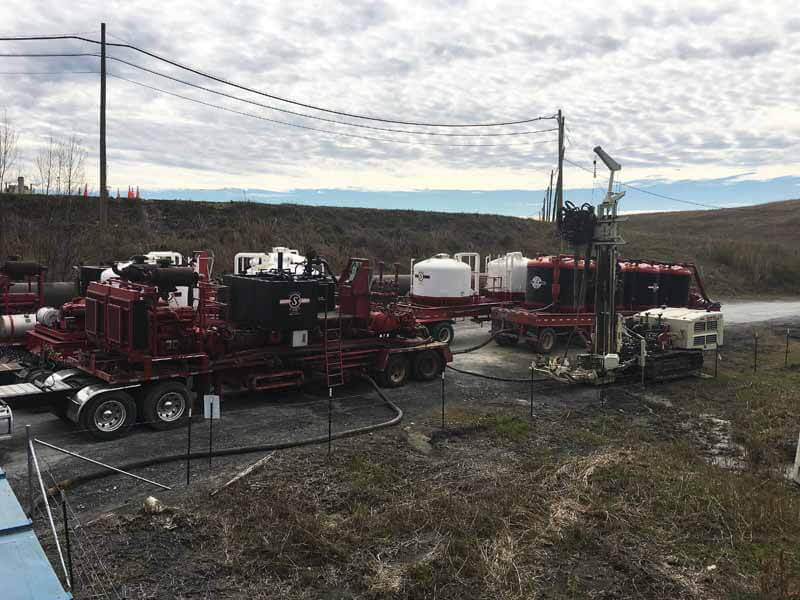
An oilfield cement pumping unit was used to pump cement slurry during the abandonment process. In all, nearly 20,000 gallons of slurry was used. The 8150LS (right) was used to penetrate the concrete pipe in the lagoon.
Unused since the early 1970s, a 48-in. diameter discharge pipe in a 2-million-gallon industrial wastewater lagoon was tapped for abandonment to remove the potential for a damaging environmental release. The pipe was initially installed in the lagoon, which is currently in use, with the sluice gate on the lagoon side, while the other end was left open-ended. The condition of the sluice gate was unknown but had most likely reached the end of its design life.
The Walker-Hill Environmental (WHE) team, led by Daren Bracey, Project Manager, knew one end of the culvert was 60-ft. below grade, but over the years, dirt and debris had been piled on the other end eventually causing it to be 30-ft. below current ground surface.
Flying Blind
Daren said, “Finding the exact location of the culvert was most challenging, especially since we couldn’t see either end of it. We needed a good hole in the pipe to install our 4-in. pipes which were to be used for supply and return of grout. If either seal were to fail, it might prevent filling the culvert with grout, thus not accomplishing the abandonment of the culvert and the potential for an environmental release would remain.”
There was a chance if the pipe collapsed or the sluice gate in the pond started leaking or deteriorated, the lagoon could drain and release 2 million gallons of wastewater into the environment. “We needed a good hole in to the pipe,” he added, “to install and seal our 4-in. pipe to facilitate pumping and returning grout so it didn’t leak and the grout wouldn’t go into the pipe and not accomplish sealing the pipe.”
The Plan Comes Together
WHE mobilized a Geoprobe® 7822DT, with driller Dennis Herrera and technician Jack Womble, to locate the crown of the 48-in. concrete pipe. Great care was taken to insure a plumb hole was advanced. The soil was inspected to ensure stability of the levee during sonic drilling, and to confirm the ability to seal the 4-in. casing.
The field team then started knocking off the steps of their plan.
Upon completion of the exploratory borings at the levee portion of the site, a Geoprobe® 8150LS sonic rig, with driller Rodney LaBrosse, and technicians Colby Pounds and Tyler Smith, advanced to the upper end of the concrete pipe with 4-in. tooling, then overrode with 6- and 8-in. tooling to the top of the pipe.The 4-in. tooling was used to penetrate through the concrete pipe, and was then removed from the borehole. Hydraulic connectivity to the lagoon was verified not to exist. The 6-in. tooling was then pulled from the hole, and a 4-in. casing was installed to act as a vent during filling, then grouted in place as the 8-in. tooling was removed from the borehole.
The crew then moved to the lower portion of the site to locate and penetrate the concrete pipe in a similar manner to set an injection port for pumping a grout slurry into the pipe.
The cementing operation was completed using an oilfield cement pumping unit to continuously pump the cement slurry from the lower portion of the pipe toward the levee to ensure no voids in the cement plug. After pumping was completed, 470 barrels (19,733 gallons) of cement slurry were pumped to seal the 48-in. concrete pipe.
Proper Planning Results in Success
Daren believes this project was a great success due to properly considering and planning for all the possible hazards and conditions, preparing the crews for the step-by-step approach, and utilizing the proper equipment to locate and penetrate the concrete pipe and setting casing. “All steps in the process were designed and implemented to reach the final goal of cementing the 48-in. concrete lagoon discharge pipe,” Darren added, “eliminating the future liability of an unexpected discharge from this pipe into the bayou or Mississippi River.
As Gary Hill, WHE Owner, reminds us all, “Success is not achieved alone; there was lots of communication between all parties involved, and a guiding hand from the Lord above!”
Contact Us
1835 Wall Street
Salina, Kansas 67401
Phone: (785) 825-1842
Photo Gallery

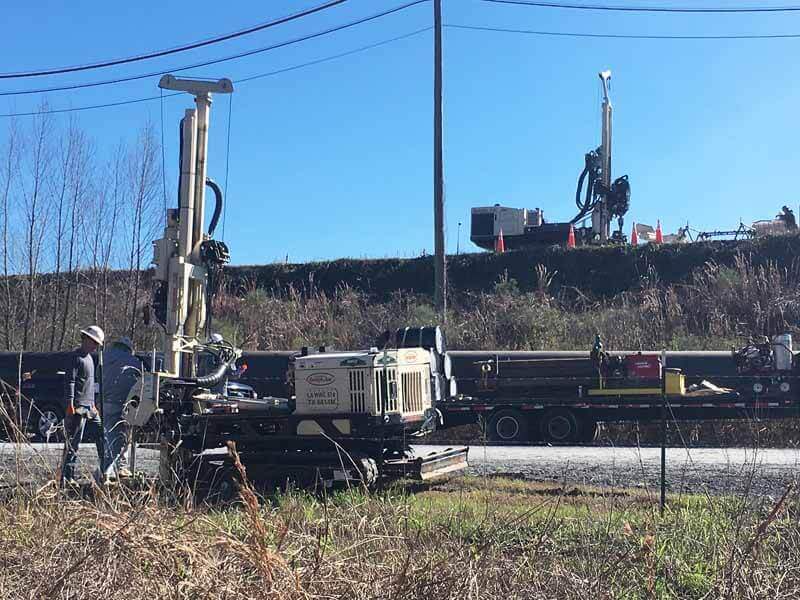
Related Articles
Geoprobe® Introduces Drill Rig Telemetry to the Drilling Industry — monitor rig operations easily through our customer portal, Centerpoint Connected.
ID: 14625 | Date:
The 8150LS fits inside a 40-ft. shipping container - perfect for overseas shipment.
ID: 14616 | Date:
Geoprobe® international service expertise keeps the 7822DT working in the field, not sidelined in the shop.
ID: 14613 | Date:
Pullback power of 7822DT outperforms conventional rigs, overcoming sand friction when driving 4-inch casing.
ID: 14608 | Date:
7822DT’s power and versatility excel at pushing cones and handling diverse geotechnical tasks like here at a Nike facility in Beaverton, Oregon.
ID: 14606 | Date:
Related Videos
ID: 14189
Geoprobe® Sonic Drilling Products
ID: 14188
Geoprobe® Sonic Stack Rack Overview
ID: 14115
Geoprobe® MD4 Display Overview
ID: 13461


